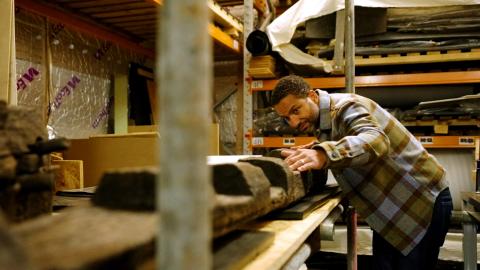Battle of Gettysburg
The Confederacy would be out-supplied rather than out-fought.
Simon Schama
Morale aside, the North can sustain higher casualty rates (and it does) because it's twice as populous as the South. By the end of 1862, 670,000 soldiers are mobilised for the Union, the biggest army in military history. In addition, 82,000 escaped slaves sign up as soldiers. The South loses the slaves that power their economy and now face highly motivated men eager for revenge against their former masters. By 1865, blacks come to form 10% of the union army.
But it's more than simple numerical advantage that gives the North the edge. The South's economy is in free-fall, largely dependent as it is on falling sales of its cash crop, cotton. In contrast, the North has a modern, mass producing, diverse industrial economy. And Lincoln uses his entire infrastructure as a war machine.
He has 38,000 km of railway line (all placed under governmental control) to deliver troops and supplies at a speed never seen: The South has less than half that, and mostly privately run. 25,000 Union troops are sent 2000 km south in just seven days on a journey that by road would have taken two months. The North can replenish their frontlines with 700 tonnes of supplies a day. By war's end, it will have provided two million muskets to its men.
Under Meig, production of clothing in the North doubles and he supplements this with purchases from as far afield as Paris. In true Civil War cliché, Meig's brother, Henry, is Quartermaster General to the Confederates. But Henry is no match for his brother and Confederate soldiers often march and fight barefoot.
It was said that you could tell where rebel soldiers had passed by the bloody footprints on the ground.
Simon Schama
The South never grasps the modern war they're fighting. In the winter of 1863 Southern troops starve even though they are just 50 kms from their capital, Richmond. Lacking logistics, the South cannot deliver the final blow.
Lincoln also realises the advantage that his 80,000 km of telegraph network brings him. He has telegraph lines connected into the war department and reads every decoded telegram so that for the first time, a war leader can direct up to the minute orders to his generals. (He's even known to sleep in the telegram room)
The tragedy of the American Civil War is that the old tactics of lines of armies coming towards each other are maintained despite the industrial scale body-counts. The increased destruction is caused by new weapons that could reload eight times faster than traditional muskets. (In many ways, this War is a preview of the millions that would be slaughtered in the First World War.)
And with 200 war correspondents and 1500 photographers showing the horror of war to civilians, Lincoln makes sure he wins the war for public opinion. His Gettysburg address, after the battle in July 1863, that costs 5,000 soldiers their lives, is so inspiring that American schoolchildren still learn it today. It begins with a reminder of the past American Revolution, 'Fourscore and seven years ago…' and ends hoping for a future of 'government of the people, by the people, for the people'.
Did you know?
Many of the first Union soldiers went into battle wearing the identical grey to their Confederate foes. With a sudden influx of a quarter of a million men, any colour would initially do including brown and green, The battle which has been seen as the most decisive of the war, Gettysburg, came about almost by accident when Lee's army in Pennsylvania were searching for footwear and ran into the army of General Meade. Later that year Lee actually curtailed his plan to attack Meade because of 'the want of supplies of shoes, clothing and blankets'…Lee had read enough about the Napoleonic wars to know armies never won with frostbitten feet. Simon Schama: An American Future
















